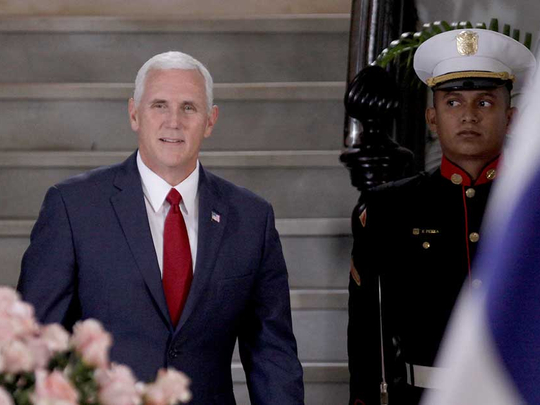
US Vice-President Mike Pence concluded on Friday a four country tour of Latin America after stop-offs in Colombia, Argentina, Chile and Panama. While Venezuela was not part of the tour, the political crisis in that country hung over the trip following Donald Trump’s polarising remarks that he is considering “military options” to intervene there.
The eyes of much of the international business and governmental worlds are currently on the continent — partly because of the destabilising political effects of the Caracas crisis for the wider region, including bordering states of Brazil and Colombia, and the fact that Venezuela is the third largest oil exporter to the United States and has the world’s largest proven oil reserves. In this prominent context, Pence on his first trip the region as vice president — yet again — showed himself to be an effective foreign ambassador for the administration compared to the blustering Trump.
Not only did Pence calm concerns about the US position on the crisis after the president’s “military options” rhetoric, an unfortunate comment given long memories on the continent of US interventionism there. He has also emphasised US commitment to economic, political, and security partnerships throughout the hemisphere, and added his weight to the emerging coalition of countries seeking to isolate Venezuela which was underlined recently when Canada and a dozen Latin American nations signed a resolution that calls the Caracas government illegitimate and demands a return to democracy.
Pence’s diplomatic skills have now surfaced in four international trips since he assumed office in January: including to Eastern Europe a few weeks ago; Asia-Pacific in April; and Western Europe in February. In all cases, the former governor of Indiana has helped reassure allies and defuse Trump’s often raucous rhetoric from his views on North Korea to Nato.
The growing global stature of the vice-president is being fuelled, partly, by international disdain with Trump. A Pew Global poll found in June that around three quarters of those surveyed had little or no confidence in the president’s international leadership and policies, including his plans for the Mexican border wall, and the partial roll-back of the Obama-era liberalisation initiative toward Cuba. Remarkably, Trump already enjoys less support from foreign public than did George W. Bush at the height of his own foreign policy travails after the controversy of the Iraq invasion.
While this Trump factor in international relations is ‘new’, in Pence assuming such a high global profile, he is following a pattern whereby the last three incumbents of his job as vice president — Joe Biden, Dick Cheney, and Al Gore — all enjoyed sizeable influence in not just foreign policy but also domestic affairs too. Indeed, Cheney, who was a predominant voice in many of Bush’s big decisions, including the US-led invasion of Iraq, is widely viewed as the most powerful ever holder of the office.
Part of the reason why Pence could become an increasingly key figure in this administration’s foreign policy is that it remains unclear how much sway US Secretary of State Rex Tillerson and Defence Secretary James Mattis hold with Trump. This is especially the case with Tillerson and media reportage recently speculated he may soon be standing down from his post.
Another relevant factor is that, at 70, Trump was last November the oldest person ever to win the US presidency. In so doing, he surpassed the previous record held by Ronald Reagan who was 69 at the time of the 1980 election.
This elevates the possibility that, especially if Trump wins a second term in 2020, Pence might be required to assume the presidency upon the incumbent’s unanticipated death or physical incapacity. And it is partly for this reason that Trump chose a significantly younger running mate (Pence is 58) with wide-ranging political experience who, in the nuclear age, he perceived to be capable of assuming the top job should that be necessary.
History underlines the crucial role that vice presidents stepping up to the presidency have played and it is perhaps Harry Truman who best exemplifies this. Within weeks of assuming office after Franklin Roosevelt’s death, Truman had to make several hugely consequential and controversial decisions, including the dropping of atomic bombs on Hiroshima and Nagasaki. He also attended soon after taking over from Roosevelt the landmark Potsdam conference with the Soviet Union and the United Kingdom to decide how to administer the defeated Nazi Germany.
Even if Trump survives the full duration of his presidency, which appears most likely given his health record — unless he is impeached or decides to unexpectedly stand down before the end of his first or a second term of office — Pence could still get his hands on the top job if he and the administration are perceived to have been successful in coming years. This is because the vice-presidency has become perhaps the single best transitional office to the Oval Office in recent decades, and it is very plausible that Pence will run for the presidency himself in the future, potentially in 2020 (if Trump does not run again) or 2024 if not.
Indeed, since 1960, four sitting vice-presidents (Richard Nixon in 1960, Hubert Humphrey in 1968; Walter Mondale in 1984; and Gore in 2000) won their respective party’s presidential nomination, but then lost the general election. Meanwhile, two vice-presidents have been elected president (Nixon in 1968 and George H.W. Bush in 1988).
Taken overall, Pence’s trip reinforced his role as an increasingly prominent player in international affairs. Moreover, his hosts on this latest Latin America trip were well aware that there is a significant chance he could become president himself in the 2020s, if not before, which means his global influence may only grow.
— Andrew Hammond is an Associate at LSE IDEAS at the London School of Economics










